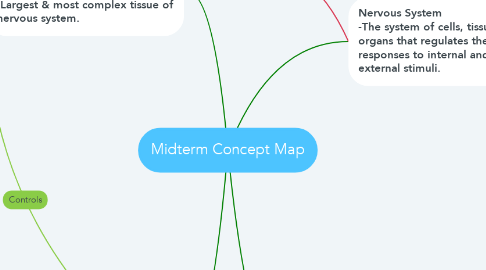
1. Brain -Weighs over 3 lbs.; pinkish gray tissue. -Largest & most complex tissue of nervous system.
1.1. 4 Major Region
1.1.1. Cerebrum -Connected by Corpus Callosum Separated by Falx cerebri
1.1.1.1. Right Cerebral Hemisphere -Creativity
1.1.1.2. Left Cerebral Hemisphere -Logic
1.1.1.3. Lobes of Cerebrum
1.1.1.3.1. Frontal lobes -motor area
1.1.1.3.2. Parietal Lobes -Sensory area
1.1.1.3.3. Temporal Lobes -Auditory & olfactory
1.1.1.3.4. Occipital Lobes -Vision
1.1.2. Cerebellum -Connected by Vermis -Separated by Falx cerebli
1.1.2.1. Coordination of muscular activity
1.1.3. Brainstem -Connects cerebrum to spinal cord
1.1.3.1. Midbrain -Eye & head movement
1.1.3.2. Pons -breathing
1.1.3.3. Medulla Oblongata -Reflex center, impulses
1.1.4. Diencephalon
1.1.4.1. Thalamus -Main sensory relay center
1.1.4.2. Hypothalamus -homeostasis
1.1.4.3. Epithalamus
1.2. Meninges
1.2.1. Dura mater
1.2.1.1. Periosteal Layer -Inner surface of the skull
1.2.1.2. Meningeal Layer -Outer covering of the brain
1.2.2. Arachnoid mater -Weblike middle layer
1.2.3. pia mater
2. Contraction -resulting in shortening of a muscle, used to perform positive work or to accelerate a body part.
2.1. Myofibrils -Densely packed, rodlike contractile element
2.2. Sarcomere -Smallest contratile unit of muscle
2.3. Myofilaments -are the filaments of myofibrils, constructed from proteins, principally myosin or actin.
2.3.1. Thick Filaments -Composed if protein myosin -has rodlike tail and two globular heads
2.3.1.1. Tail -Two interwoven, heavy polypeptide chains
2.3.1.2. Heads -Two smaller, light polypeptide chains called crossbridges
2.3.2. Thin Filaments -Chiefly composed of protein actin -Contains the active site to which myosin head attach during contraction
3. Nervous System -The system of cells, tissues, and organs that regulates the body's responses to internal and external stimuli.
3.1. Function
3.1.1. Perceive Stimuli
3.1.2. Integration
3.1.3. Response
3.2. 2 types of Cell
3.2.1. Neuroglia -Support, Insulate & protect delicate neuron
3.2.2. Neuron -Nerve Impulse Transmission
3.2.2.1. Classification of Neurons
3.2.2.1.1. Functional
3.2.2.1.2. Structural
3.3. Division
3.3.1. Central Nervous System
3.3.2. Peripheral Nervous System
3.3.2.1. Sensory or Afferent
3.3.2.1.1. Somatic -Skin, Skeletal, & joints
3.3.2.1.2. Visceral -Internal Organs
3.3.2.2. Motor or Efferent
3.3.2.2.1. Somatic nervous system/voluntary -skeletal muscle
3.3.2.2.2. Autonomic nervous system/involuntary -Smooth and cardiac muscle
4. Osssification(or osteogenesis) -in bone remodeling is the process of laying down new bone material
4.1. Intramembranous Ossification
4.1.1. Bone development from fibrous membranes.
4.1.2. Flat bones of the skull, the mandible, and the clavicles.
4.2. Endochondral Ossifcation
4.2.1. Bone development from hyaline cartilage.
4.2.2. The flat bones of the face, most of the cranial bones, and a good deal of the clavicles

